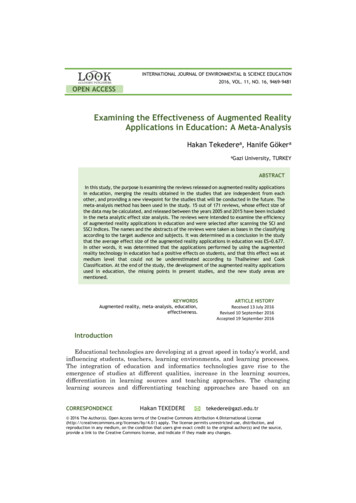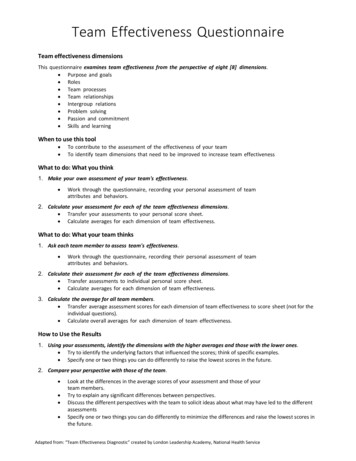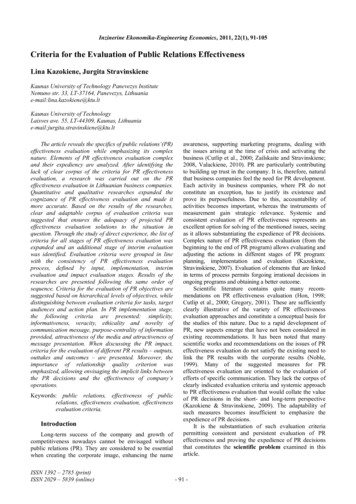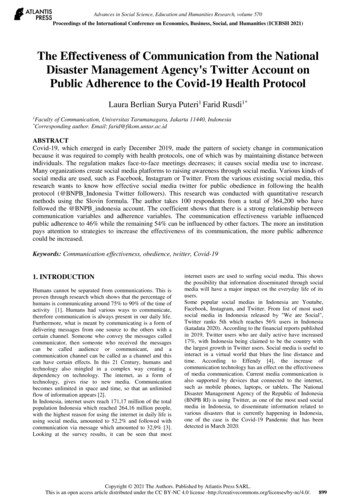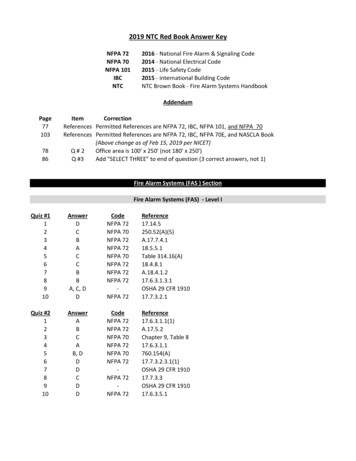
Transcription
Examining the Effectiveness of Adopting an InductiveApproach to the Teaching of English GrammarExamining the Effectivenessof Adopting an Inductive Approachto the Teaching of English GrammarWONG Chi Ho Henry (Main researcher)WONG Mei Chu Evelyn, TANG Siu Lun Terence (Other researchers)Ning Po CollegeSummaryAdopting an inductive approach to English grammar teaching can help students torediscover their subconscious knowledge of English grammar and bring it to consciousness,as the grammar of a language is acquired through abstracting a set of grammatical rules fromlanguage data, rather than through imitation (Zhou, 2008). Although some local ESL teachersmay be convinced of the benefits of the inductive approach to the learning of Englishgrammar, it seems that not many of them have tried it out with their students due to their lackof faith in its effectiveness and / or students’ readiness. This paper reports on a research studyinvestigating the effectiveness of adopting an inductive approach to the teaching of Englishgrammar with six Secondary 1 students. The subjects, after learning how to use Wh-questionwords, were given a fill-in-the-blanks test and a sentence-production test with a view toexamining its effectiveness. A follow-up group interview with all the six subjects wasconducted to explore students’ feelings towards the inductive learning approach. The findingsshow that brighter students (mean score: 6 out of 7) benefited more from the inductiveapproach than the average (mean score: 3.5) or weaker (mean score: 2.5) students. In theinterview, five out of the six interviewees responded that they preferred the inductiveapproach more and found it more effective in learning English grammar. It is hoped that thisreport can give Hong Kong ESL teachers some ideas on using the inductive approach.教 育 研 究 獎 勵 計 劃1 0 / 11177
教育研究報告匯編1. IntroductionLanguage learners play a determining role in a language classroom as they directlyaffect the way the teachers teach, that is, the teaching approach (Ellis, 1997). Therefore, thesuitability of teaching approaches for language learners and more importantly, the search forteaching methodology which yields the best learning outcomes in language learners hasalways been the hot issue for discussion.Many educationalists have suggested that explicit teaching approaches have a moresignificant effect on the second language acquisition (Pica, 1983; cited in Ellis, 1997; Norris& Ortega, 2000; cited in Erlam, 2003) when compared to simple exposure or meaning-drivencommunication. There are numerous forms of explicit instruction (Norris & Ortega, 2000;cited in Erlam, 2003) and the two most commonly used yet controversial ones are thedeductive approach and the inductive approach. Foreign language methodologists andteachers have long debated whether deductive or inductive teaching yields better outcomesfor second language acquisition. Each of them carries both strengths and weaknesses(Thornbury, 1999).As language learners and teaching approaches are the two main factors determining thewhole teaching and learning scenario, the investigation of the learners’ attitudes towards thetwo types of explicit instruction will probably provide educationalists with some ideas aboutwhich teaching approach is more preferable in the second language acquisition.In Hong Kong, English is regarded as one of the most important subjects in localmainstream schools. Most students learn English as a second language and they receiveexplicit instruction. Considerable emphasis is also placed on grammar learning (TheCurriculum Development Council, 2001).Chomsky (2002) suggests that an inductive approach can help students to rediscovertheir subconscious knowledge of English grammar and bring it to consciousness, as thegrammar of a language is acquired through abstracting a set of grammatical rules fromlanguage data, rather than through imitation. It seems, however, that a number of teachers arestill not fully convinced of the benefits of students’ self-discovery of grammar rules whereas,some still argue the direct transmission of grammar knowledge (i.e. a deductive approach)教 育 研 究 獎 勵 計 劃1 0 / 11178
Examining the Effectiveness of Adopting an InductiveApproach to the Teaching of English Grammarmay not facilitate students’ long-term memory and application of the grammar rules acquiredin appropriate contexts.As aforementioned, learners’ opinions are of great importance in examining the value ofdeductive and inductive instruction in the second language acquisition. Therefore, research onlearners’ opinions towards the two teaching approaches in learning grammar has probablybecome of interest to educators and language teachers in Hong Kong. The investigation ofthis area is essential.Learners’ opinions towards deductive and inductive instruction are the topic of interest.The purpose of the present study, specifically, is to examine the learners’ attitudes towardsdeductive and inductive grammar teaching in English as a second language in a particularsecondary one mainstream language classroom in Hong Kong. The teacher in that particularclassroom uses various methods, including inductive and deductive, in teaching grammar.The former teaching approach involves rule explanation while the latter requires the learnersto generalize patterns or rules from examples. We are interested in the learners’ opinionsabout the lessons with deductive instruction and inductive instruction. The opinionsinvestigated which are the key variables in this survey research include two dimensions, thevalue of the teaching approaches in helping them grasp the grammatical concepts as well asmotivating them to learn. The motivation here refers to the ‘intrinsic motivation’ whichdepends on how much the students are interested in the task or the lesson.Since our students often have difficulty forming grammatically correct ‘Wh-questions’involving the confusion of ‘be’ and ‘do’, in this action research, the teacher researchers taughtstudents how to form ‘Wh-questions’ using an inductive approach and conducted a test aftertwo days. A follow-up group interview with all the six interviewees was conducted two daysafter the test. It is hoped that, through our action research study, reflection and sharing offindings and insights, our English teachers, as well as other English teachers in Hong Kong,can believe in and adopt an inductive approach to teaching grammar so as to increasestudents’ learning effectiveness.教 育 研 究 獎 勵 計 劃1 0 / 11179
教育研究報告匯編2. Review of Related Literature2.1 Definitions of some key concepts Deductive and inductive approachesDeductive approach is defined as a process that proceeds from the presentation of a ruleby a teacher to the provision of examples in which the rule is applied (Thornbury, 1999;Norris & Ortega, 2000; cited in Erlam, 2003) followed by language practice that students canengage in. It involves applying a general rule to specific instances (Gollin, 1998).Inductive approach is almost a reverse process of deductive approach. It starts withexposing students to examples of language use or even immersing them in the use of thetarget language items and then prompts students to generalize the patterns of the language(Thornbury, 1999; Decoo, 1996; Gollin, 1998). It involves inferences from the particularinstances to general (Gollin, 1998) and discovering rules (Thornbury, 1999). That is whysome researchers, like Robinson, used the term inductive as rule search.2.2 Research in deductive and inductive instructionThere is little research on learners’ attitudes or opinions towards the two approaches.However, there is a great deal of quantitative experimental research on the relativeeffectiveness of the two approaches on the acquisition of certain grammatical items (Erlam,2003; Herron and Tomasello, 1992; Robinson, 1996; Seliger, 1975; Shaffer, 1989).Although each of these studies adopted different experimental designs, all of them usedat least two experimental groups, each of which received different types of instruction,including deductive and inductive instruction. After the experiment, the subjects of differentgroup were required to do at least a task or a test in which the scores were calculated andtheir performance were used to measure the effectiveness of the approaches. The tests ortasks administered were taken in various forms, including written forms (Herron andTomasello; 1992; Shaffer, 1989) and oral forms (Erlam, 2003).These studies presented conflicting evidence to the effectiveness of deductive andinductive instruction. Shaffer (1989) did not uncover any significant difference between thetwo approaches but only a trend slightly in favor of the inductive instruction. Erlam (2003),Robinson (1996) and Seliger (1975) detected an overall advantage for deductive instruction教 育 研 究 獎 勵 計 劃1 0 / 11180
Examining the Effectiveness of Adopting an InductiveApproach to the Teaching of English Grammarwhile Herron and Tomasello (1992) gave an opposite conclusion. Due to these conflictingfindings, no definite conclusions can be made.The limitations in these studies should be noted as they merely focused on theeffectiveness of the two approaches on the acquisition of the language and only the learners’performance in comprehension and production of the language items was taken into account.These studies overlooked the importance of the learners’ perceptions of the value of theteaching approaches in helping them grasp the grammatical concepts and motivating them tolearn. The real value and importance of these two teaching approaches may sometimes bebetter revealed by qualitative survey research.The other limitation of most of the aforementioned studies is that they used adults as thesubjects, except the studies done by Erlam (2003) and Shaffer (1989). It is conceivable thatthe results or conclusions obtained from studies using adults as subjects may not beapplicable to the cases of school-aged learners. Therefore, after conducting this review, wewere still no closer in understanding the value and importance of the deductive and inductiveteaching in students’ points of view.3. Research Design (Methods and Instruments):3.1 Teacher ResearchersThe three teacher researchers were the English teachers of their own S.1 classes. All of themhad possessed at least five years’ experience in teaching English at both junior and seniorsecondary levels. Also, they were all English majors at university and had completed a postgraduate education course on English language teaching.3.2 SubjectsBased on the results of the S.1 English admission test, the top two students from thebrightest class, the average two students from the middle-stream class, and the weakest twostudents from the low-stream class were invited to participate in the action research. By thetime the study was conducted, all of them had reached the age of 12 and had been taught bythe English teacher researchers for five months.教 育 研 究 獎 勵 計 劃1 0 / 11181
教育研究報告匯編3.3 InstrumentsTwo days after the teacher researchers had taught students how to form ‘Wh-questions’using an inductive approach (i.e. students’ self-discovery of knowledge), students were giventhe following test:Q.1 What? My name is David Chan.Q.2 Where? I live in Kwun Tong.Q.3 When? I usually do my homework at night.Q.4 Which? I like ‘Harry Potter’ most.Q.5 Who? My best friend is John.Q.6 Why? It is because the students and teachers inthis school are very nice.Q.7 How? I go to school by bus.Remarks:1.Since the focus of the action research was on grammatical accuracy, the content of thequestions formed was not counted.2.For each grammatical question formed (including word order, tense, the use of ‘verb-tobe’ and ‘do/does’), 1 mark was awarded.3.The test scripts of all the six subjects were marked by an independent marker who wasnot involved in the study. The independent marker was an Assistant English Teacher inour school.4.The test results of the different classes were compared to see:a. whether the adoption of an inductive approach is more effective than a deductiveapproach to grammar teaching; andb. to what extent students of varied ability (i.e. high, mid, and low) can benefit from aninductive approach to grammar teaching.教 育 研 究 獎 勵 計 劃1 0 / 11182
Examining the Effectiveness of Adopting an InductiveApproach to the Teaching of English Grammar3.4 Focus Group InterviewA focus group interview consisting of 6 students (2 high-ability students, 2 mid-abilitystudents, and 2 low-ability students in each class) was conducted to elicit interesting findingsfor a more in-depth analysis. The questions formed were based on students’ performance inthe test. The interview was conducted in Cantonese to encourage students’ free and frankresponse.Interview QuestionsQ.1 Which approach did you find more interesting to you?Q.2 Which approach did you consider more useful? Why?Q.3 Would you like to learn grammar using an inductive approach or a deductive approach?Why?Q.4 What were the difficulties encountered when learning grammar using an inductiveapproach? How did you overcome the difficulties?Q.5 What kinds of students do you think are suitable for an inductive approach to learninggrammar? Why?Q.6 Do you have any other comments or suggestions regarding the two approaches togrammar learning?教 育 研 究 獎 勵 計 劃1 0 / 11183
教育研究報告匯編3.5 ProceduresTable 1PeriodResearch Procedures23 Feb (Wed)Teaching students how to form 'Wh-questions' using an inductive approach in a 55-min lesson(Students were given lots of 'Wh-questions' and asked to find out the features of 'Wh-questions' ingroups such as 'word order, tense, the use of 'verb-to-be' and 'do/does'')25 Feb (Fri)Conducting the TestBy 25 Mar (Fri)Marking of all students' test scripts by an independent marker who is not involved in the actionresearchBy 15 Apr (Fri)Focus Group InterviewA focus group interview (i.e. high, mid, low classes) consisting of 6 students (2 high-abilitystudents, 2 mid-ability students, and 2 low-ability students in each class) was conducted to elicitinteresting findings for a more in-depth analysis.By 24 Jun (Fri)Drafting the research reportBy 29 Jul (Fri)Finalising the research reportBy 31 Aug (Wed)Submitting the finalised research report to Hong Kong Teachers' Centre4. Findings4.1 Test4.1.1 Test ResultsTable 2 Test Results Showing That Most Students are Able to Form Some Questions CorrectlyStudent 1(Hi-ability)Student 2(Hi-ability)Student 3(Mid-ability)Student 4(Mid-ability)Student 5(Low-ability)Student .40101114Q.51110003Q.61000001Q.71110104664332教 育 研 究 獎 勵 計 劃1 0 / 11184
Examining the Effectiveness of Adopting an InductiveApproach to the Teaching of English Grammar4.1.2 Inductive Approach being more effective, especially for brighter studentsFrom the above findings, it is clear that most students have attained the right ways toform the grammatically formed questions by exploring various examples provided by theirEnglish teachers. Among them, Student 1 and 2 had near-perfect performance. The othersperformed satisfactory. Only Student 6 got 1 mark and he should have found it intricate tolearn with inductive approach.In addition, the higher level students have done much better than their weakercounterparts in the test. They are far more capable of following the inductive way of learningwhen attending the English lessons and learning various grammatical concepts.Table 3 An Analysis of the Grammatically Wrong Questions Formed by StudentsQuestion(s) wrongly formedTenseWord OrderWhere are you live?Q.2Where you are live?Where are you living?When does you do homework?Q.3When I did homework?When you is do homework?Q.4Which book you like?Which 'Harry Potter' is I liked?Who are my best friend?Q.5Who does your best friend?Who was my best friend?Why it is the student and teachers in thisschool very nice?Why is it like in this school?Why are you very like the students andQ.6very nice teachers?Why it does it the students like thisschool teacher?Why they is like students and schoolteachers very nice?Q.7How you do go to school by bus?How is I go to school?教 育 研 究 獎 勵 計 劃1 0 / 11185‘Verb-to-be’and ‘Do/does’
教育研究報告匯編4.1.3 Word OrderSome weaker students could not figure out the correct word order and formed quite anumber of wrong questions throughout teachers’ inductive English lessons. Eight questionshave word order errors.They could not attain the ideas from the examples given by teachers. When they askopen questions for more information starting with an interrogative word or phrase such asWhat, How, Who, When, Which (film), this word or phrase must go in front of the auxiliaryor modal verb. For example, ‘When are you going to Paris?’, ‘How can I help you?’, ‘Whichfilm (interrogative phrase) did you see?’The only exception to this rule is the verb ‘to be’ which does not take an auxiliary in thepresent and past simple tenses. They just have to invert the subject and verb in open andclosed questions. For example, ‘Are you tired?’, ‘Were you late for your appointment?’, And‘How are you?’However, we do not add an auxiliary for subject questions. In questions where thequestion word or phrase is the subject, there is no added auxiliary in the present or pastsimple nor any inversion. ‘Who plays football in this class?’, ‘Which car will arrive first?’,and ‘Who loves you?’4.1.4 TenseTo all S.1 students, the subject of English tenses is a vast and difficult one, so itdeserves its own special place as a conspicuous component in the English curriculum. Asrevealed by students’ test performance, four questions were formed with inappropriate tenses.This clearly demonstrates that broadly speaking, students of various level of Englishcompetency are lack of confidence and ability to tackle the tense issue when askingquestions.教 育 研 究 獎 勵 計 劃1 0 / 11186
Examining the Effectiveness of Adopting an InductiveApproach to the Teaching of English Grammar4.1.5 ‘Verb-to-be’ and ‘Do/does’Thirteen questions were formed with inappropriate use of ‘Verb-to-be’ and ‘Do/does’.This further backs up the state that the difference between Chinese (Ss’ L1) and English (Ss’L2) is weakening and undermining their ability of employing grammatically questions intheir English studies.4.2 InterviewGroup interviews with students furnish another source of evidence that the test resultsare more accurate, trustworthy, useful, and believable than student ratings and writtencomments. The teacher researchers consider the interview results as most useful for teachingimprovement.4.2.1 Inductive Approach being more effective, especially for brighter studentsThe teacher researchers think that “Inductive approach” is better because, on one hand,if students can find a grammatical rule by themselves, it might be harder for them to forgetthe rule than just learning from a teacher. That is to say, for a teacher, it is better to askstudents a question before explaining a grammatical rule than to just explain the rule.On the other hand, “Inductive approach” is something like giving a mystery. Starting aclass with mystery is very effective to attract students to the class. Students might try to find agrammatical rule, just like solving a mystery. Finally, this process will lead to moresuccessful grammar learning.From a student’s perspective, an inductive approach enables him/her to think morebefore formulating some concrete ideas about a language item. Learning acquisition shouldbe voluntary. Thus an inductive approach sounds better which will give students morethinking opportunities than a deductive approach. Also through an inductive approach tolearning, students can have various answers throughout peer interactions and independentthinking. The inductive approach seems to benefit the active students more than the passiveones though.教 育 研 究 獎 勵 計 劃1 0 / 11187
教育研究報告匯編Teachers would like to use inductive approach to teach English. Then their students’ability of thinking will increase by using inductive approach since the students try to find therules from given examples and then understand by themselves. As a result, their brains workwell. In fact, it is definitely important for learners to think and find out the law to a problemrather than being spoon-fed by their instructors during the passive learning process withdeductive approach.In addition, learning in lessons with the inductive approach is more meaningful.Deductive English learning is similar to behaviorism methodology and this kind ofmethodology doesn’t help the student understand the grammar in a useful way. They willonly memorize the verbs for a period of time.4.2.2 Inductive Approach being more interestingFrom the days of grammar translation, the deductive approach to language learning, inwhich a grammar rule is explicitly presented to students and followed by practice applyingthe rule, has been the bread and butter of language teaching around the world and still enjoysa monopoly in many course books and self-study grammar books. However, the low levels ofattainment associated with this type of teaching, plus an ever-developing awareness of thecomplexity of language brought by corpus linguistics, have pointed out problems withdeductive instruction. Rules given by teachers and textbooks are often seen, at best, as helpfulbut over-simplistic generalizations; and at worst, as fallacious and misleading distortions ofreal languages which contribute little or nothing to learner’s productive mastery of linguisticforms. In view of this, inductive learning is conducted in the English lessons. Students cannow enjoy learning English in various ways but all share the feature that they do not startwith explicit presentation of a language rule. Rather, the learners are prompted in some waysto discover for themselves how language works. As a result, they find English learning farmore interesting and interactive.It avoids the interference of the first language. Trying to teach grammar to learnersexplicitly by telling them the rules without using grammar in context makes it difficult forlearners to store the target features in their long-term memory and for these features tobecome grammatically automatized. That is one of the reasons why Chinese learners tend to教 育 研 究 獎 勵 計 劃1 0 / 11188
Examining the Effectiveness of Adopting an InductiveApproach to the Teaching of English Grammarremember grammar rules by translating them into their mother tongue. In this case, not only alot of grammatical mistakes, but also cultural differences, which result in improper use of thelanguage, appear in their language learning. Teaching grammar through communicative tasksor CR activities which make the language meaningful and interesting for them can help themto use the language in real-time communication more automatically.4.2.3 Difficulties Encountered when using inductive approachThe inductive approach represents a more modern style of teaching where the newgrammatical structures or rules are presented to the students in a real language context(Goner, Phillips, and Walters, 1995, 135). The students learn the use of the structure throughpractice of the language in context, and later realize the rules from the practical examples. Forexample, if the structure to be presented is the comparative form, the teacher would begin thelesson by drawing a figure on the board and saying, “This is Jim. He is tall.” Then, theteacher would draw another taller figure next to the first saying, “This is Bill. He is taller thanJim.” The teacher would then provide many examples using students and items from theclassroom, famous people, or anything within the normal daily life of the students, to createan understanding of the use of the structure. The students repeat after the teacher, after eachof the different examples, and eventually practice the structures meaningfully in groups orpairs. (Goner, Phillips, and Walters, 1995, 135-136) With this approach, the teacher's role isto provide meaningful contexts to encourage demonstration of the rule, while the studentsevolve the rules from the examples of its use and continued practice (Rivers and Temperley,1978, 110).While inductive approach is firmly based in many English teaching in HK schools andenjoys much popularity with English learners, it does not yet seem to have gained widespreadacceptance among the majority of frontline English teachers. In important ways it goesdirectly counter to many traditional educational ideas: it puts more responsibility on learners,posits a less central role for the teachers, and makes no promises about when or whetherstudents will master the content. In a city like HKSAR (part of mainland China), where theeducation system remains rooted in conservative Confucian beliefs, one would expect to faceresistance to inductive teaching in the classrooms.教 育 研 究 獎 勵 計 劃1 0 / 11189
教育研究報告匯編I hear and I forget.I see and I remember.I do and I understand.attributed to Confucius (551-479?BC)The above-mentioned criteria for creditable PG rules are particularly relevant todeductive (rule-driven, top-down) teaching, which leads from an explicit presentation ofmetalinguistic information, the provision of a set of abstractions, isolated language rules atautonomous levels of description subsequently accompanied by model sentences, to theirapplication to concrete L2 representations and practice tasks only after the clarification hasbeen studied and digested (Komorowska 1993:120). This technique simply means providinglearners with the ready grammar rule, describing in details how the new structure is formed,what its components are, and in what type of context it can be used. All the information isgiven in the form of a mini-lecture, during which the teacher usually employs grammaticalterminology. After the explanation, the learners are provided with examples illustrating thenew structure, which they analyse, and are subsequently asked to apply the rule to newsentences. They are typically expected to memorize the rule (and relevant ‘exceptions’). Thisform of teaching offers a clear clarification of new language items, which makes the learningtask easier and less intimidating and is time-effective, leaving more time for practicing thenew structures. Among other advantages, it gets straight to the point, and therefore can betime-saving. It respects the intelligence and maturity of many especially adult students andacknowledges the role of cognitive processes in language acquisition. It confirms manystudents' expectations about classroom learning. (Thornbury 1999:30) This type of teaching isprevalent in the majority of traditional educational institutions.In short, adopting the inductive approach to Chinese learners still faces a lot ofchallenges: 1) For these adult learners, they have already developed their own learning style.Some of them may feel more comfortable with the teacher explaining rules to them instead ofdiscovery totally by themselves. In other words, they feel more secure when they get a lot ofsupport, even a lot of corrections from the teachers. 2) Since their level is not at the beginninglevel anymore, they have more chances to meet some complicated or difficult structures. Aninductive teaching approach may not meet their explicit request of how language works. Theymay question the teachers’ knowledge and ability of the target language (especially to nonnative English teachers) if the teachers do not answer their questions in an explicit way.教 育 研 究 獎 勵 計 劃1 0 / 11190
Examining the Effectiveness of Adopting an InductiveApproach to the Teaching of English GrammarBasically, the changing of the deductive approach to the inductive approach takes quitea long time. It becomes particularly difficult to adopt widely with young learners because ofthe strictly-controlled national exam-oriented syllabus in China. It works quite well with theadult learners since their purpose is to develop their communicative competence withoutbeing under the pressure of exams. Whether the grammar teaching approach is effective forthem depends on whether it is really useful for their real-life communication with nativeEnglish speakers either in their work or studies. However, the problem is still a key one: Iflanguage teachers do not start teaching young learners with an appropriate approach anddevelop their skills and abilities of language learning, how can they become successfullanguage learners as they grow up?Furthermore, some English teachers may like to use inductive approach, but they maynot use it. That’s because this approach takes a lot of time. The number of English class perweek in secondary schools has been getting fewer. So, it is difficult to take a lot of time toone lesson.5. DiscussionA language test is for the teacher researchers to verify the teaching effectiveness ofinductive English lessons. After the test, it is found that such a post-lesson test is beneficial toboth teachers and students. Teachers can make out how well their students have learnt thetopic ‘Asking English Questions Correctly’. Also, they can use testing as a useful tool toboost students’ learning.Furthermore, it has long been considered that testing can be more beneficial thanstudying alone. While it may seem that spending more time studying is one of the best waysto maximize learning, research has demonstrated that taking tests actually helps studentsbetter remember what they’ve learned, even if it wasn’t covered on the test. The studyrevealed that students who studied and were then tested had better long-term recall of thematerials, even on information that was not covered by the tests. Students who had extra timeto study but were not tested had significantly lower recall of the materials. Obviously, theteachers have designed this research very well.教 育 研 究 獎 勵 計 劃1 0 / 11191
教育研究報告匯編5.1 Word OrderThere are 2 main types of questions: Open and closed questions. Closed questions arethose for which the answer can be only ‘y
curriculum innovations: a Hong Kong case study. The Curriculum Journal 21(3), 313-332. Loh, H. (1993). Peer assisted study session in anatomy for nursing students. Proceedings of the conference peer tutoring: Learning by teaching, held 19-21 August 1993, (pp. 193-202). University of Auckland, Auckland. Ng, Y. F. (1996). The effectiveness of .



